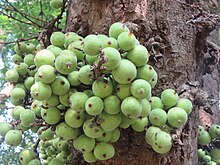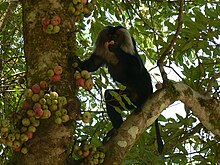Ficus racemosa
| Ficus racemosa | |
|---|---|

| |
| Scientific classification | |
| Kingdom: | Plantae |
| Clade: | Tracheophytes |
| Clade: | Angiosperms |
| Clade: | Eudicots |
| Clade: | Rosids |
| Order: | Rosales |
| Family: | Moraceae |
| Genus: | Ficus |
| Subgenus: | F. subg. Sycomorus |
| Species: | F. racemosa
|
| Binomial name | |
| Ficus racemosa | |
| Synonyms | |
|
Ficus glomerata | |
Ficus racemosa, the cluster fig, red river fig or gular,[2] is a species of plant in the family Moraceae. It is native to Australia and tropical Asia. It is a fast-growing plant with large, very rough leaves, usually attaining the size of a large shrub, although older specimens can grow quite large and gnarled. It is unusual in that its figs grow on or close to the tree trunk, termed cauliflory.
The fruits are commonly eaten as a vegetable after the seeds have been discarded, and made into stir-fries and curries. The fruits are a favourite staple of the common Indian macaque. It serves as a food plant for the caterpillars of the two-brand crow butterfly (Euploea sylvester) of northern Australia.[3]
In Hinduism
According to the Shatapatha Brahmana, the Audumbara tree was created from the force of Indra, the leader of the gods that came out of his flesh when he overindulged in soma:
From his hair his thought flowed, and became millet; from his skin his honour flowed, and became the aśvattha tree (Ficus religiosa); from his flesh his force flowed, and became the udumbara tree (Ficus glomerata); from his bones his sweet drink flowed, and became the nyagrodha tree (Ficus indica); from his marrow his drink, the Soma juice, flowed, and became rice: in this way his energies, or vital powers, went from him. [4]
In the
- The Lord of amulets art thou, most mighty: in the wealth's
- ruler that engendered riches,
- These gains are lodged in the, and all great treasures. Amulet,
- conquer thou: far from us banish malignity and indigence,
- and hunger.
- Vigour art thou, in me do thou plant vigour: riches art thou, so
- do thou grant me riches.
- Plenty art thou, so prosper me with plenty: House-holder, hear
- a householder's petition.[7]
It has been described in the story of Raja
The tree has been worshipped as Abode under which Lord
In Buddhism
Both the tree and the flower are referred to as the Audumbara (
In
Uses


The Ovambo people call the fruit of the cluster fig eenghwiyu and use it to distill ombike, their traditional liquor.[10]
Other uses
The bark of Ficus racemosa is used as a
References
- . Retrieved 19 November 2021.
- ^ "Ficus racemosa". European and Mediterranean Plant Protection Organization (EPPO). Retrieved 1 December 2020.
- ISBN 0-643-09027-4.
- ^ "Satapatha Brahmana, Kanda XII, adhyaya 7, brahmana 1". 18 July 2013.
- ^ Monier-Williams, Monier (1899, 1964). A Sanskrit-English Dictionary (London: Oxford University Press), pp. 175, 186. Retrieved 19 Nov 2008 from "Cologne University" at http://www.sanskrit-lexicon.uni-koeln.de/scans/MWScan/MWScanpdf/mw0175-ujjha.pdf and http://www.sanskrit-lexicon.uni-koeln.de/scans/MWScan/MWScanpdf/mw0186-udaya.pdf.
- ^ See, e.g., Shyam Singh Shashi (1999), Encyclopaedia Indica (Anmol Publications), Ch. 9 "The Tree Cult," esp. pp. 241, 244-46. Retrieved 19 Nov 2008 from "Google Books" at https://books.google.com/books?id=jMmYDrm_7NAC&dq=%22Atharva+Veda%22+%2Budumbara&pg=PA245
- ^ Ralph T. H. Griffith (trans.) (1895-6). Hymns of the Atharva Veda, pp. 236-7. Retrieved 19 Nov 2008 from "Sacred Texts" at http://www.sacred-texts.com/hin/av/av19031.htm.
- ISBN 0-8047-2258-7.
- ISBN 0-8048-2058-9.
- ^ Shaanika, Helvy (26 October 2012). "Ombike – a potent traditional brew". New Era. Archived from the original on 28 October 2012.
External links
- "Ficus racemosa". Australian Plant Name Index (APNI), IBIS database. Centre for Plant Biodiversity Research, Australian Government.

